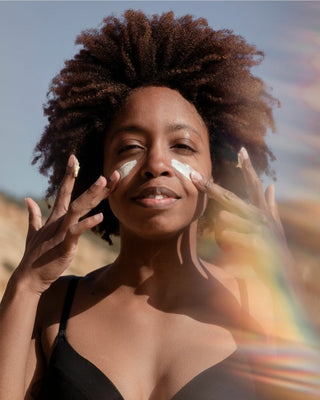Lathering your skin in sunscreen is a well known beauty secret and beach bag necessity (sun protection is essential!). Even if you’re one of the lucky ones who do not burn like a lobster after 25 minutes outside, sun exposure can cause wrinkles and premature aging, but most importantly, it can cause life-threatening skin cancer. We depend on SPF to protect our skin and our health from harmful sun rays. But unfortunately, all sunscreens are not created equal.
Have you thought about switching to mineral-based sunscreen?
Mineral sunscreen, as opposed to chemical sunscreen, is exactly what it sounds like: sunscreen that uses minerals (most commonly zinc oxide and titanium dioxide) to protect from the sun. Basically, the minerals sit on top of your skin and reflect UV rays so they don’t reach you (just like a bunch of tiny mirrors reflecting the light). Chemical sunscreens work by absorbing the rays through a chemical reaction. While this process protects rays from burning your skin, your body still absorbs the chemicals, and the chemicals can seep into your bloodstream. Since mineral sunscreen is not absorbed into the skin like chemical formulas, it’s thought that it a more non-toxic option (plus, it’s better for the environment). However, just because a sunscreen says it’s mineral does not always mean it does not also contain chemicals. Look for options that claim 100 percent mineral-based active ingredients, and research the ingredients of any sunscreen you’re unsure about.
Now, have you thought about how safe your sunscreen is for the environment?
The reality is that the products covering our skin wash off when we enter the water, and it adds up! Research tells us that 4,000 to 6,000 tons of sunscreen enters reef areas annually. Unfortunately this does not spread out quickly or evenly over the entire ocean, but usually concentrates at popular tourist sites (like the Great Barrier Reef!). It isestimated that 90% of snorkelling/diving tourists are concentrated on 10% of the world’s reefs. This means that our most popular reefs are exposed to the majority of sunscreens. If you think you are in the clear when your sunscreen is labelled “reef safe,” think again.
Sunscreens labelled “reef safe” aren’t guaranteed to be harmless when they get into our underwater ecosystems as there is no national standard and currently no scientific proof that any of the current sunscreen options are entirely safe for the marine eco-system. While no sunscreen has been proven to be completely ‘reef safe,’ those with titanium oxide or zinc oxide (which are natural mineral ingredients) have not been found to be harmful to corals. On the other hand products containing ingredients like oxybenzone and octinoxate have been banned in Hawaii after a study found that these chemicals seep into young coral and contribute to coral bleaching.
SHOP STRAIGHT FROM THE LIANDRA SWIM CURATED FOR YOU:

The Kind Sunscreen
SPF30
$29.00

We Are Feel Good Inc
SPF50
$27.95

Mother SPF
SPF30
$42.00

Seed & Sprout
SPF50
$29.00

People4Ocean
SPF50
$29.95


